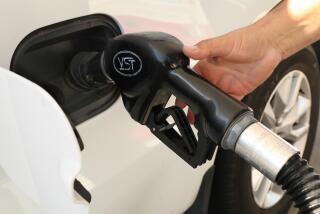Californians Set Record at the Gas Pump
- Share via
California motorists bought more than 1 billion gallons of gasoline in March, a record for the month, in what is described as the first direct evidence that the recent nose dive in gasoline prices may be changing driving habits and boosting fuel consumption.
The results also support expectations of a sharp increase in summer travel as motorists take to the road, starting this Memorial Day weekend and building toward the normal yearly peak of gasoline usage in August.
But a recent turnaround in retail prices might dampen the exhilaration of climbing behind the wheel: Gasoline analyst Dan Lundberg noted that prices have climbed about 2 cents a gallon already this month and predicted that they will spurt another 2 to 3 cents over the course of the long holiday weekend.
Figures Give Pause
Nonetheless, an average price of 92 cents a gallon still looks like a bargain compared to $1.21 at the start of the year. But the March figures clearly give pause to those who have argued that the decline in oil prices would not significantly affect usage.
The figures from the California Board of Equalization, which administers gasoline and other state tax laws, are traditionally the nation’s first monthly reports on gasoline usage. As such, they are a precursor of national trends, according to Lundberg.
The tax-collection figures measure actual retail purchases and thus the actual pumping of gasoline into cars. More current industry estimates, based on the movement of fuel out of primary storage tanks, have shown a continued surge in usage in recent weeks.
After unremarkable totals in January and February, when the decline in crude oil prices was only gradually showing up at the pump, California’s gasoline sales in March spurted 14% over February and 2.5% above the year-ago total.
“This is an extraordinary increase. It is a harbinger that the spring and summer are really going to see a surge in driving,” said Lundberg, owner of the Los Angeles-based Lundberg Survey, which tracks gasoline prices nationally.
Shrinking Inventories
Although the sharp rise in demand has not created shortages thus far, gasoline inventories have been coming down gradually this year, and some worry that a continued boom could cause tight supplies to develop. Meanwhile, refinery capacity in the United States has been shrinking as companies close older, less productive facilities. That could cause shortages if inventories are depleted and the remaining refineries are unable to keep up with demand.
According to the Board of Equalization, the sale of about 1.02 billion gallons exceeded the March record of 999.9 million gallons set in 1978, the state’s and the nation’s biggest gas-guzzling year.
March’s consumption in California was also the third highest of any month. The level is considered unusually high for the time of year. Gasoline use normally begins to build in the spring, rising each month through August.
“This is coming very early in the year,” said a spokeswoman for the tax board. “We wouldn’t be surprised if we see many more billion-gallon months this year.”
Hard to Interpret Demand
Atlantic Richfield, the market leader in California, cautioned that it is too soon to predict a banner year for gasoline sales and said the abruptness of the price decline, followed by the recent firming up of prices, make it hard to interpret true demand.
An Arco spokesman said the company’s sales have continued at the March pace, whereas analysts say there is normally a seasonal increase as spring unfolds. The Arco official said, “We’re not getting our hopes unduly high.”
The American Petroleum Institute’s barometer of national gasoline demand, based on gallons transferred out of primary storage tanks, showed a 6% increase in March and a 2.8% increase in April--well above last year’s growth rate of 1.8%.
The March increase in California’s gasoline use, which is taxed by the state at 9 cents a gallon on an excise basis, boosted revenues for the month to $92.5 million--an increase of $2.2 million over the year-ago results. The revenue from the sales tax has not been calculated, but it is based on a percentage of the price and thus would have fallen on a per-gallon basis. It is not yet known whether the higher volume would offset that.
More to Read
Sign up for Essential California
The most important California stories and recommendations in your inbox every morning.
You may occasionally receive promotional content from the Los Angeles Times.










